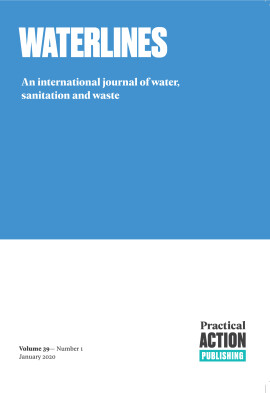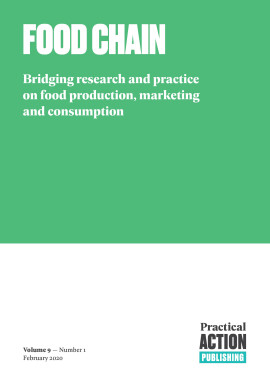Integrated approaches to enabling the most vulnerable to participate in markets
Even when markets become more accessible to poor people in general, wealth differentials occur and the most vulnerable are the ones excluded. The reasons for their exclusion are complex and inextricably linked with many aspects of their lives; an integrated approach takes these multiple dimensions of poverty into account, whilst addressing their deep levels of poverty through employment and enterprise. This article focuses on reaching those who are excluded from markets due to pervasive social discrimination and other challenges specific to their disability and health context. Two case studies of people with disabilities and those affected by HIV/ AIDS describe entry points and key services required to facilitate and sustain their participation as employees and enterprise owners. They demonstrate how successful models use participation in economic activities to achieve sustainable impact through stimulating attitude change, and create a more level playing field for their access to markets and wider development processes.Albu, M. (2004) ‘Evaluation of an action-research project by the National Union of Disabled Persons of Uganda (NUDIPU) and APT Enterprise Development’, UK.
Braithwaite, J. and Mont, D. (2008) ‘Disability and poverty: A survey of World Bank poverty assessments and implications’, HDNSP, World Bank, Washington D.C.
Carney, D. (2002) ‘Sustainable livelihoods approaches: Progress and possibilities for change’, DFID, London.
Elwan, A. (1999) Poverty and Disability, a survey of the literature; Social Protection Discussion Paper No. 9932; The World Bank Group, Washington D.C.
Elliot, D., Gibson, A. and Hitchins, R. (2008) ‘Making markets work for the poor: Rationale and practice’, Enterprise Development and Microfinance 19 (2):
Lwanga-Ntale, C. (2003) ‘Chronic poverty and disability in Uganda’, Development Research Training, Kampala, Uganda.d2003s
Munasinghe, C. (2008) Building the Capacity of People with Disability in Northern Uganda to Access their Livelihoods: A Handbook for Disability Advocates and Practitioners, APT Enterprise Development UK/NUDIPU Uganda, Uganda.
NACC (2007) HIV and AIDS Situation in Kenya, National AIDS Control Council, Nairobi.
Parker, R. G., Easton, D. and Klein, C. H. (2000) ‘Structural barriers and facilitators in HIV prevention: A review of international research’ AIDS 14: S22-S32.
Pronyk, P. M., Hargreaves, J. R. and Morduch, J. (2007) ‘Microfinance programs and better health: Prospects for sub-Saharan Africa’, JAMA - Journal of the American Medical Association 298: 1925-1927.
SEEP (2008) SEEP Network Guidelines for Microenterprise Development in HIV and AIDS-Impacted Communities: Supporting Economic Security and Health, Book 2 For Microenterprise Development Practitioners, SEEP, Washington D.C.
Sumartojo, E. (2000) ‘Structural factors in HIV prevention: Concepts, examples, and implications for research’, AIDS 14: S3-S10.
UNAIDS/WHO (2007) AIDS Epidemic Update Paper 07, UNAIDS/WHO.
UNAIDS/WHO (2008) Kenya Epidemiological Country Profile on HIV and AIDS, Fact Sheet Update.
Albu, M. (2004) ‘Evaluation of an action-research project by the National Union of Disabled Persons of Uganda (NUDIPU) and APT Enterprise Development’, UK.
Braithwaite, J. and Mont, D. (2008) ‘Disability and poverty: A survey of World Bank poverty assessments and implications’, HDNSP, World Bank, Washington D.C.
Carney, D. (2002) ‘Sustainable livelihoods approaches: Progress and possibilities for change’, DFID, London.
Elwan, A. (1999) Poverty and Disability, a survey of the literature; Social Protection Discussion Paper No. 9932; The World Bank Group, Washington D.C.
Elliot, D., Gibson, A. and Hitchins, R. (2008) ‘Making markets work for the poor: Rationale and practice’, Enterprise Development and Microfinance 19 (2):
Lwanga-Ntale, C. (2003) ‘Chronic poverty and disability in Uganda’, Development Research Training, Kampala, Uganda.d2003s
Munasinghe, C. (2008) Building the Capacity of People with Disability in Northern Uganda to Access their Livelihoods: A Handbook for Disability Advocates and Practitioners, APT Enterprise Development UK/NUDIPU Uganda, Uganda.
NACC (2007) HIV and AIDS Situation in Kenya, National AIDS Control Council, Nairobi.
Parker, R. G., Easton, D. and Klein, C. H. (2000) ‘Structural barriers and facilitators in HIV prevention: A review of international research’ AIDS 14: S22-S32.
Pronyk, P. M., Hargreaves, J. R. and Morduch, J. (2007) ‘Microfinance programs and better health: Prospects for sub-Saharan Africa’, JAMA - Journal of the American Medical Association 298: 1925-1927.
SEEP (2008) SEEP Network Guidelines for Microenterprise Development in HIV and AIDS-Impacted Communities: Supporting Economic Security and Health, Book 2 For Microenterprise Development Practitioners, SEEP, Washington D.C.
Sumartojo, E. (2000) ‘Structural factors in HIV prevention: Concepts, examples, and implications for research’, AIDS 14: S3-S10.
UNAIDS/WHO (2007) AIDS Epidemic Update Paper 07, UNAIDS/WHO.
UNAIDS/WHO (2008) Kenya Epidemiological Country Profile on HIV and AIDS, Fact Sheet Update.
Albu, M. (2004) ‘Evaluation of an action-research project by the National Union of Disabled Persons of Uganda (NUDIPU) and APT Enterprise Development’, UK.
Braithwaite, J. and Mont, D. (2008) ‘Disability and poverty: A survey of World Bank poverty assessments and implications’, HDNSP, World Bank, Washington D.C.
Carney, D. (2002) ‘Sustainable livelihoods approaches: Progress and possibilities for change’, DFID, London.
Elwan, A. (1999) Poverty and Disability, a survey of the literature; Social Protection Discussion Paper No. 9932; The World Bank Group, Washington D.C.
Elliot, D., Gibson, A. and Hitchins, R. (2008) ‘Making markets work for the poor: Rationale and practice’, Enterprise Development and Microfinance 19 (2):
Lwanga-Ntale, C. (2003) ‘Chronic poverty and disability in Uganda’, Development Research Training, Kampala, Uganda.d2003s
Munasinghe, C. (2008) Building the Capacity of People with Disability in Northern Uganda to Access their Livelihoods: A Handbook for Disability Advocates and Practitioners, APT Enterprise Development UK/NUDIPU Uganda, Uganda.
NACC (2007) HIV and AIDS Situation in Kenya, National AIDS Control Council, Nairobi.
Parker, R. G., Easton, D. and Klein, C. H. (2000) ‘Structural barriers and facilitators in HIV prevention: A review of international research’ AIDS 14: S22-S32.
Pronyk, P. M., Hargreaves, J. R. and Morduch, J. (2007) ‘Microfinance programs and better health: Prospects for sub-Saharan Africa’, JAMA - Journal of the American Medical Association 298: 1925-1927.
SEEP (2008) SEEP Network Guidelines for Microenterprise Development in HIV and AIDS-Impacted Communities: Supporting Economic Security and Health, Book 2 For Microenterprise Development Practitioners, SEEP, Washington D.C.
Sumartojo, E. (2000) ‘Structural factors in HIV prevention: Concepts, examples, and implications for research’, AIDS 14: S3-S10.
UNAIDS/WHO (2007) AIDS Epidemic Update Paper 07, UNAIDS/WHO.
UNAIDS/WHO (2008) Kenya Epidemiological Country Profile on HIV and AIDS, Fact Sheet Update.
Albu, M. (2004) ‘Evaluation of an action-research project by the National Union of Disabled Persons of Uganda (NUDIPU) and APT Enterprise Development’, UK.
Braithwaite, J. and Mont, D. (2008) ‘Disability and poverty: A survey of World Bank poverty assessments and implications’, HDNSP, World Bank, Washington D.C.
Carney, D. (2002) ‘Sustainable livelihoods approaches: Progress and possibilities for change’, DFID, London.
Elwan, A. (1999) Poverty and Disability, a survey of the literature; Social Protection Discussion Paper No. 9932; The World Bank Group, Washington D.C.
Elliot, D., Gibson, A. and Hitchins, R. (2008) ‘Making markets work for the poor: Rationale and practice’, Enterprise Development and Microfinance 19 (2):
Lwanga-Ntale, C. (2003) ‘Chronic poverty and disability in Uganda’, Development Research Training, Kampala, Uganda.d2003s
Munasinghe, C. (2008) Building the Capacity of People with Disability in Northern Uganda to Access their Livelihoods: A Handbook for Disability Advocates and Practitioners, APT Enterprise Development UK/NUDIPU Uganda, Uganda.
NACC (2007) HIV and AIDS Situation in Kenya, National AIDS Control Council, Nairobi.
Parker, R. G., Easton, D. and Klein, C. H. (2000) ‘Structural barriers and facilitators in HIV prevention: A review of international research’ AIDS 14: S22-S32.
Pronyk, P. M., Hargreaves, J. R. and Morduch, J. (2007) ‘Microfinance programs and better health: Prospects for sub-Saharan Africa’, JAMA - Journal of the American Medical Association 298: 1925-1927.
SEEP (2008) SEEP Network Guidelines for Microenterprise Development in HIV and AIDS-Impacted Communities: Supporting Economic Security and Health, Book 2 For Microenterprise Development Practitioners, SEEP, Washington D.C.
Sumartojo, E. (2000) ‘Structural factors in HIV prevention: Concepts, examples, and implications for research’, AIDS 14: S3-S10.
UNAIDS/WHO (2007) AIDS Epidemic Update Paper 07, UNAIDS/WHO.
UNAIDS/WHO (2008) Kenya Epidemiological Country Profile on HIV and AIDS, Fact Sheet Update.
Sustainable Livelihoods and Pro-poor Market Development
Susan Johnson, Susan Johnson
Enterprise Development & Microfinance, Vol. 20 (2009), Iss. 4 P.333
https://doi.org/10.3362/1755-1986.2009.037 [Citations: 3]- Value chain financing: evidence from Zambia on smallholder access to finance for mechanization
- Boosting financial inclusion through social assistance reform: evidence-based approach in selecting a payment system
- Developing agro-pastoral entrepreneurship: bundling blended finance and technology
- Building frontline market facilitators' capacity: the case of the ‘Integrating Very Poor Producers into Value Chains Field Guide’
- Impact of COVID-19 on livestock exports from Somalia and the Horn of Africa


